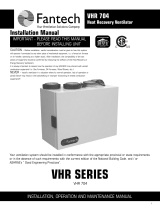
GB.CACA.050101
Specifications are subject to alteration without notice.
6 www.swegon.se
4.3 Temperature control
4.3.1 Control sequence
When heating is required, first, the speed of the heat recovery
rotor will increase. Then the electric air heater, if fitted, will
begin to pulsate output. If no electric air heater is installed,
or if the air heater output proves inadequate, the speed of
the supply air fan will be slightly decreased so that the correct
temperature will be obtained.
4.3.2 ERS control
Compact Air operates on the principle of ERS control (exhaust
air temperature-related supply air temperature control). This
means that the supply air temperature is controlled in relation
to the exhaust air temperature.
This type of temperature control offers optimum operational
economy and heat recovery, and eliminates the need of any
reheater.
Compact Air offers two options for controlling the supply air
temperature: Either according to Section 4.3.3 so that it follows
the exhaust air temperature or according to Section 4.3.4 so
that its operation maintains the desired room temperature if
the temperature of the exhaust air is high.
4.3.3 Supply air temperature
The supply air temperature is controlled in relation to the
exhaust air temperature.
Control can be carried out according to one of three alternative
steps.
Step 1 offers the best operational economy and cooling capa-
city in warm rooms, however steps 2 and 3 may be necessary
in day nurseries, for instance, where children often spend time
at floor level.
Provision is available for presetting the min. supply air
temperature. If the supply air temperature is below the min.
preset value for more than 5 minutes, the unit will be shut
down for one hour.
The difference between the three steps is illustrated in the
chart below.
15 16 17 18 19 20 21 22 23 24 25 26 27 28 29 30 31 32
15
16
17
18
19
20
21
22
23
24
14
Supply air temperature °C
Exhaust air temperature °C
The plotted broken lines show the difference between steps 1 and 3
at a given exhaust air temperature (23 °C).Step 1 gives a supply air
temperature of 18.8 °C and step 3 gives 21 °C.
4. DESCRIPTION OF
CONTROL SYSTEM
4.1 General
The settings that can be entered and the effect of various
control functions of the Compact Air unit are described in this
section. A diagrammatic presentation of the functional princi-
ple and a circuit diagram are also included.
The procedure for entering the various settings is described
in section 5.
4.2 The air flows
When air flow settings are preset, these settings affect both
the supply air flows and the exhaust air flows at the same
time and automatically. Whenever a flow setting is altered, it
will take about 1 minute for the fans to change over to the
new speed.
The air flows can be preset as follows:
Size 8
Normal air flow, variable from 83–222 l/s (300–800 m3/h). Low air
flow, switched off or variable from 83–222 l/s (300–800 m3/h).
Size 11
Normal air flow setting, variable from 83–305 l/s (300–1100
m3/h)
Low air flow setting, switched off or variable from 83–305 l/s
(300–1100 m
3
/h).
NOTE! Normal air flow can not be selected at a lower rate than
low flow.
4.2.1 Normal flow
The air flow is preset taking into account the size of the room
and the activity pursued. It should be noted that the cooling
effect will be better, the higher the air flow rate is.
4.2.2 Low flow
Walls, furniture, carpeting etc. often also emit contaminants.
Therefore, continuous ventilation is important, even if to a
lesser extent when the premises is not being used. Swegon
recommends pre-setting the low air flow rate so that it cor-
responds to at least 1 air change per hour.
The unit can be switched off during the period otherwise
reserved for low flow, but this is not recommended.
Every time the 7-day timer or presence detector switches the unit
from normal flow to low flow operation, a filter test will be auto-
matically carried out. During this test, the unit will some-times run
at an air flow rate other than the preset flow rate.
4.2.3 Airing
This function causes the unit to run at maximum air flow
with reduced supply air temperature (set point: 10°C) for 15
minutes.
The airing function can be selected manually in the control display. If
a presence detector is used to control the unit, the automatic airing
function can be selected.
One condition for automatic airing is that the unit must have opera-
ted at normal air flow for at least 10 minutes (i.e. the detector must
have registered the presence of one or more occupants) and after
that, not registered any presence for 5 minutes.
Step 3
Step 2
Step 1

















